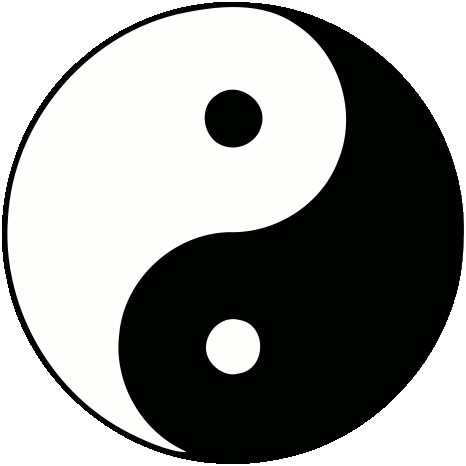~ soloing over changes ~ ~ parent scales / diatonic improv ~ 'there's 'over the river or through the trees' ... and this is 'over the river ...'
|
"It always seems impossible until it's done." |
wiki ~ Nelson Mandela |
In a nutshell. In creating discussions about Americana improv, by making the general distinction of soloing 'over' or 'through' the chords and form of the song, we can really simplify our learning process. While in most of our improvisation we combine both approaches, it's very often the musical style of a song's arrangement that helps determine the balance of improvising 'over or through' the harmony in creating our improvised dialogues. |
And while triad notes often rule the melodies of the folksy / country / pop and jamm band songs of our musical spectrum, artists are usually leaning more to soloing 'over the changes.' On the jazz horizon, 'through the changes' is more the norm and almost by necessity, as we tend to 'fill in' the spaces between principle chords with passing chords and often use these opportunities in our improvised lines with arpeggiating the chords. And in the blues ? Well, some of both of course plus a healthy bit of of trills, slides, hammer-ons everything else to add heartfelt inflections into our lines. And to help keep things on track in the following ideas and discussions, we again will follow our 'additive numerical' philosophy, adding one pitch at a time to evolve beyond our core five note nucleus; the relative major / minor pentatonic groups. |
Over the changes. In soloing over the changes, we pick what can be theory termed a 'parent scale' and use those pitches to create our melodic ideas over a whole series of key center related chords in a song. For instance, a song in 'C' major has as its parent scale the 'C' major scale. We use these pitches; C D E F G A B C, to create the melody and build up the arpeggios and chords. This approach to composition and soloing we can term diatonic, and is the general basis all of our Americana styles. And if our song moves along and modulates to other key centers? We simply use the parent scale of that key to create our melodies. For example, if we start in 'C' major and modulate to 'Eb' major, our new parent scale pitches become Eb F G Ab Bb C D and Eb. Cool ? |
Motion to Four. As discussed elsewhere, motion to the Four chord / the subdominant is by far the most common of our compositional destinations in near every song and era within the Americana book, yet how each song gets there is not. Why even the classical cats have this basic harmonic pillar and man have they devised and written out some astoundingly beautiful ways to get to Four. With this view, as we move through our spectrum of styles, we can track a gradual evolution of components used to create the various ways we get to Four. Each of these provide melodic opportunities for our improvs. So from the parent scale basis and into soloing through the possible 'opportunities', all is in the mix :) |
Getting started. In getting started as improvisors, we often begin with our most user friendly group of pitches, five pitch pentatonic group then evolve to the seven pitches of the diatonic scale. As we move towards a jazz style in our style spectrum, we end up adding in new pitches to the diatonic seven from our chromatic 12, to strengthen our cadential motions and cover key changes through modulation. All while the blue notes are ever ready to add in some of the true Americana 'blues hue.' |
'Over the chord changes' with five pitches.' This first chart holds the pitch basis for our most accessible groups of pitches for creating melody lines over chord changes. The five pitches of both the major and minor pentatonic groups are said 'to have no bad pitches' ( and they don't ) when properly ( diatonically ) paired up with their chords for creating improvised melodic lines. Examine their letter name pitches in a table format. Thinking here in C major / A minor. Example 1. |
scale degrees |
1 |
2 |
3 |
. |
5 |
6 |
. |
8 |
C major |
C |
D |
E |
. |
G |
A |
. |
C |
arpeggio |
C |
E |
G |
. |
D |
. |
A |
C |
One / C major triad |
C |
E |
G |
. |
. |
. |
. |
. |
. |
. |
. |
. |
. |
. |
. |
. |
. |
A minor |
A |
. |
C |
D |
E |
. |
G |
A |
arpeggio |
A |
C |
E |
G |
. |
D |
. |
A |
One / A minor triad |
A |
C |
E |
. |
. |
. |
. |
. |
One triad. Looks like we only get build up a single triad / chord for each of the major and minor keys from this initial five pitch grouping. No wonder there's no clunkers in the melody producing pitches :) This five note group is very often the core pitch and chord resource for writing songs for little ones; for children's songs and the lullaby melodies we cherish that are easy to sing, easy to make up new words (parody) and quickly rote learned. Here improvising with these five pitches over one major and one minor triad; pentatonic jamming here. Example 1a. |
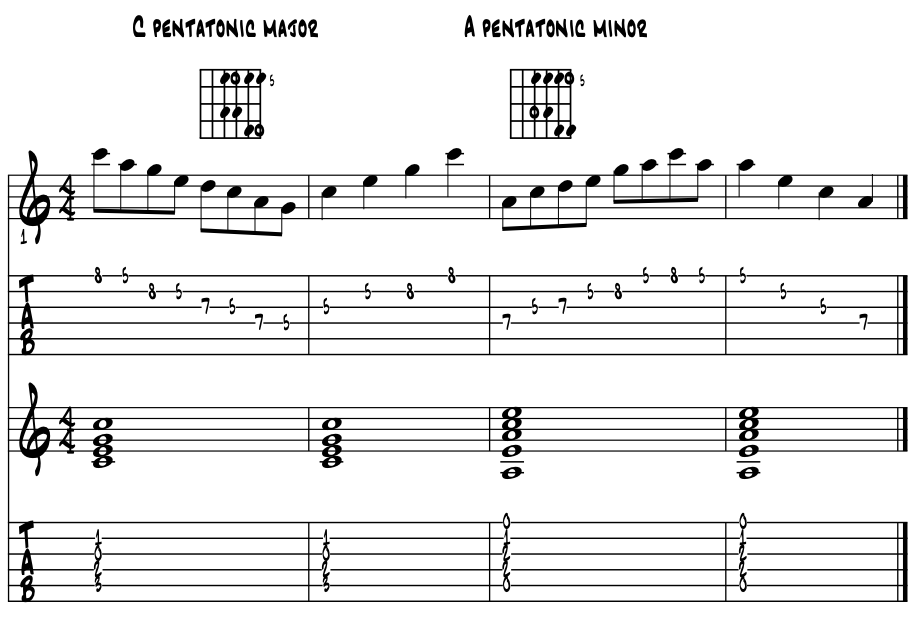 |
So the same group of pitches works perfectly fine for creating ideas for both major and minor tonalities? Yep, tis the beauty of our modern system of pitches and their integration and organization together. And didn't we create a melody line through the changes in the 2nd and 4th bars? Sure did, simply spelled out the chords tones of the triads in successive tones into arpeggios. Thus, we could say as theorists that our melodic line went more 'through the chords' and not 'over the chords.' |
Is this the basic theory for 'over the changes' with these five pitches and a major and minor triad? Sure is. And the pentatonic scale shape atop the example is the one? It is in many circles. So depending on what you need, run this shape around the neck finding the key centers for the songs you be a jamming on. And there are amazing artists who venture no further down the theory road yet never run out of ideas for soloing and composing with just these pitches? Absolutely. |
"If it sounds good it is good." |
wiki ~ Duke Ellington |
Five pitches over different chords. That our five note pentatonic group know's no clunker pitches, it's the perfect group for creating ideas over loops of different chords. Here's a two chord jam vamp using the major / minor pentatonics. Think 'A minor to Ab' major. Ex. 1b. |
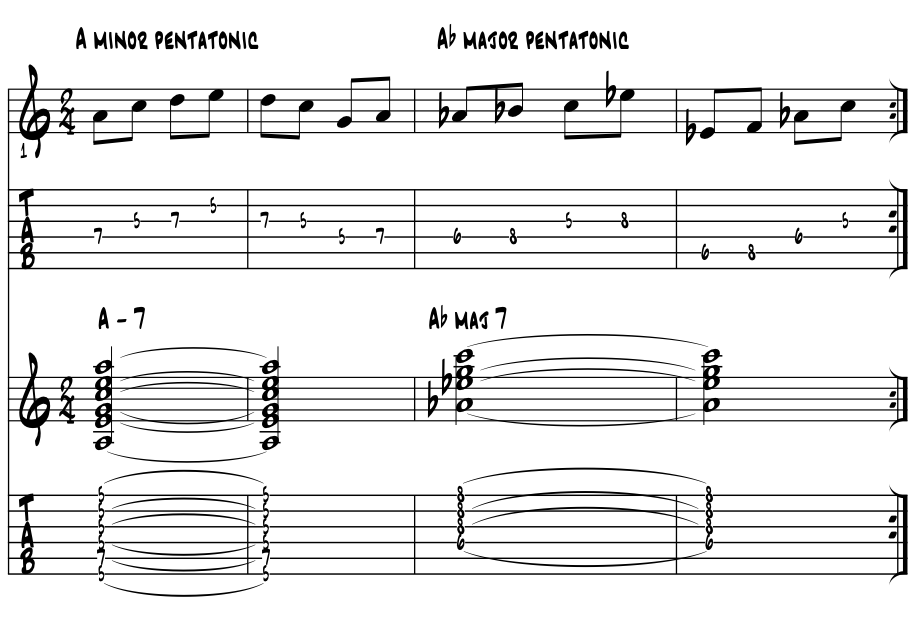 |
Cool huh ? Works like a charm. We simply applied a different parent scale for each of the two chords. So is there a parent scale for every imaginable chord? Pretty much, thus we look to simplify the process through thinking diatonically ( a discussion follows ) and with chord type, which takes us a step beyond triads with an added 7th for each chord. |
There's whole studies of the use of these pentatonic groupings for improv over all sorts of harmonies both diatonic and altered. For the advancing musician who digs these sounds and searching, there's a theory improv book titled Pentatonic Scales for Jazz Improvisation by Raymond Ricker well well worth examining and profiting by its genius. |
|
Common practice. So, you're jamming with your mates in the key of A? Locate this scale shape at the 2nd fret for major sounds and at the 5th fret for the minor and essential blues scale shape pattern. Example 1c. |
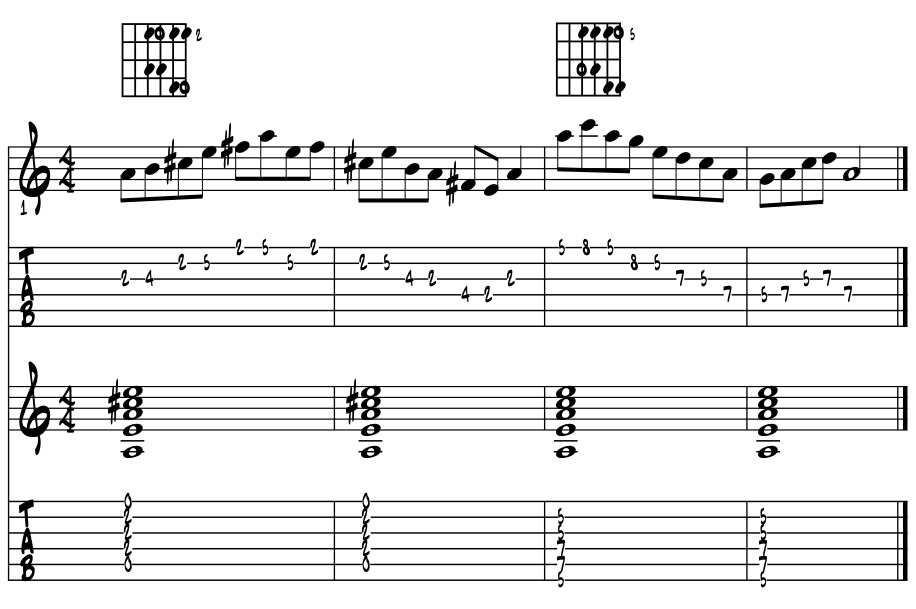 |
In this last idea, we find a sure common start spot in Americana improv. At some point along the way cats called this 'playing in the boxes, or box scales' etc. Over the decades I've had the chance to see many great rock and blues artists who never really stray to far from this one shape, they simply move it to different locations based on the key of the song, chord of the moment. It really 'works like a charm' for getting things sounding cool in a hurry when soloing over the changes. |
And while there's additional scale shapes to cover the fingerboard, here in Essentials we use the 'blues elevator' instead. We simply locate the essential coolness of the blue notes in the one shape and find those pitches over the fingerboard. The rest of the pitches in each shape more 'grist for the mill as time permits' than essential. |
Six pitches over the chords ~ minor. In all of our Americana, there might be no better art that initially defines this 'over the changes' improv approach than the blues. For hands down, the blues and its songs and form is the clear winner in the contest of number of theory rules bent and still sounding totally Americana legit, thus filling the dance floor night after night after night; back then, right now and into tomorrow's tomorrows :) |
A theory basis of the blues. One foundational pillar of the blues sounds is that we rub the minor 3rd melody pitch over chords built with a major 3rd. The blues artist 'rubs' minor against major. These two distinct sets of pitches together are a big slice of the make the magic in the pie. This theory follows in this next discussion. |
Spanning well beyond a 100 years now so probably a half dozen generations or so, in passing down the art of the regional styles of Congo Square and Delta, Memphis, Chicago, and on into Kansas City jump swing, East Coast hip and West Coast cool, rockabilly, classic blues rock, Southern blues rock, country rock and all of today's retro revivals on through to the modern takes, are all for the most part based on soloing over the changes; using a half a dozen pitches we just usually call the blues scale to work the 'blues rub' magic over the three principle chords; One / Four and Five. |
|
In this whole fantastic blues library of over the changes musical art, the consistent 'blues rub' theory goes mostly like this. Thinking 'blues in A', examine the pitches of the scale and chords followed by a realization of the pitches. Example 2. |
melody pitches |
six pitches of the minor blues scale |
||||||||
scale degrees |
1 |
. |
b3 |
4 |
#4/b5 |
5 |
. |
b7 |
8 |
blues scale |
A |
. |
C |
D |
D# |
E |
. |
G |
A |
chord pitches |
pitches of the three major blues chords |
||||||||
chord degrees |
1 |
3 |
5 |
b7 |
. |
. |
. |
. |
. |
A7 |
A |
C# |
E |
G |
. |
. |
. |
. |
. |
D7 |
D |
F# |
A |
C |
. |
. |
. |
. |
. |
E7 |
E |
G# |
B |
D |
. |
. |
. |
. |
. |
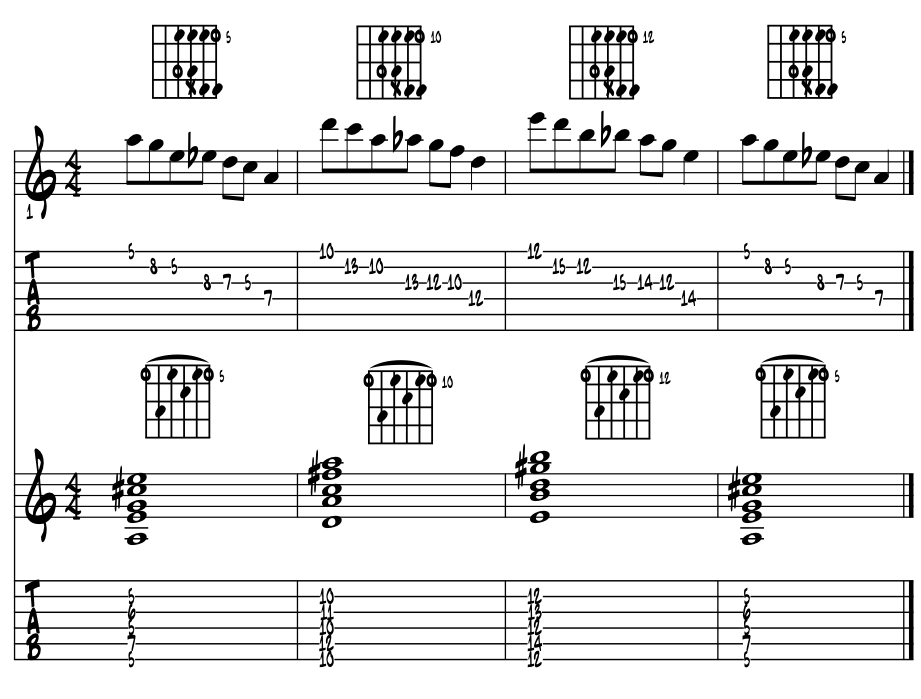 |
Did we just run the same melody idea created from the box scale over the three chords by simply moving the scale shape to the appropriate fret? Yep we sure did. Sounds fine to me. One shape moved around to the proper fret location of the barre chord. Hmmm ... Oh, out of frets? Transpose the whole idea down a step to G at the 3rd fret with the exact same shapes. Any key and position; same shapes same results :) |
So while our melody and our chord pitches share the five pitches of the pentatonic scale, there's also a few extra added for creating the chords. Examine the pitches in chart form. Example 2a. |
scale degrees |
1 |
. |
b3 |
maj 3 |
4 |
#4/b5 |
5 |
6 |
b7 |
maj 7 |
8 |
scale pitches |
A |
. |
C |
. |
D |
D# |
E |
. |
G |
. |
A |
chord pitches |
A |
B |
C |
C# |
D |
. |
E |
F# |
G |
G# |
A |
So in theory, we add four new pitches to our blues scale to make the basic chords. For in the 'ideal' world of diatonic music theory, our 'parent scale' has all the pitches to make all the licks, lines, chords and kibbles and bits nuancing of our music. But thanks to Americana blues and its influence through the styles, our perfect diatonic theory world bumps into reality and we have to negotiate it all to let the art happen. Let's combine the these two groups together. Example 2b. |
degrees |
1 |
2 |
b3 |
maj 3 |
4 |
#4/b5 |
5 |
6 |
b7 |
maj 7 |
8 |
shared pitches |
A |
B |
C |
C# |
D |
D# |
E |
F# |
G |
G# |
A |
Adding them up we have 10 different pitches. We only get 12 with the whole tamale ... in the chromatic scale that is. So two left to discover? Example 2c. |
shared blues pitches |
A |
. |
B |
C |
C# |
D |
D# |
E |
. |
F# |
G |
G# |
A |
new notes |
. |
Bb |
. |
. |
. |
. |
. |
. |
F |
. |
. |
. |
. |
chromatic scale |
A |
Bb |
B |
C |
C# |
D |
D# |
E |
F |
F# |
G |
G# |
A |
So Bb, on the flat Two (bii) scale degree and F, flat Six. Ya know if we push either the tonic A or the 5th E around a bit with a bending, where right near these two pitches anyway. We just worked the pitches from six into 10 then 12, finding the perfect closure of the pitches that the theory always brings. |
In billiards they call the process we just worked through 'running the table.' And in doing so we win the game :) Able to follow along with this last processing of the pitches? Win the theory? Just one of a number of ways to run the table and include all 12 of our pitches. |
By theory understanding the 'bends in the rules' from our purely diatonic basis, as just discussed with the pitches of the blues scale and chord relationships, in improvising 'over' rather than 'through' the chords, we might better understand the blues hue shade in Americana musics. |
Six pitches over the chords ~ major. In all fairness to the balance of all things theory, there's a six note group associated with major that comes along in the music with Americana melodies and improv fairly often. To create this group we add in the fourth degree to the five pitch pentatonic major. Examine the pitches in C major. Example 3. |
melody pitches |
six pitches of the major blues scale |
||||||||
scale degrees |
1 |
2 |
3 |
4 |
. |
5 |
6 |
7 |
8 |
C pentatonic scale |
C |
D |
E |
. |
. |
G |
A |
. |
C |
with added 4th |
C |
D |
E |
F |
. |
G |
A |
. |
C |
So basically a diatonic major / relative minor group without a leading tone? Yep. How handy? Well as most songs will eventually get to Four, nice to have the root pitch to create the chord diatonically and to land on in our improvs. Have this melody and hook under your fingers yet ? Into the wayback and thinking C major sans a leading tone 7th. Example 3a. |
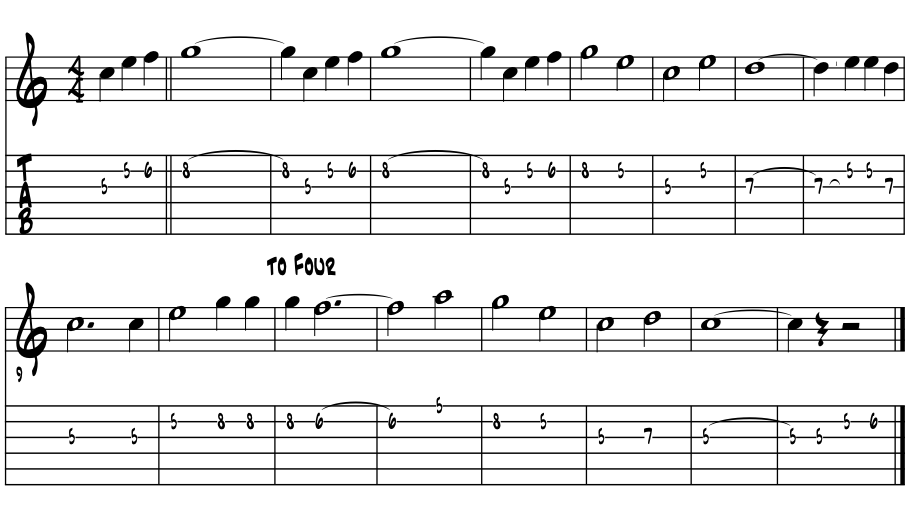 |
Got it? Cool. True true Americana adaptable to every conceivable genre of the local universe including to the near points beyond where even on the outskirts, most folks will recognize the line in just a couple of pitches and start to groove right along. |
|
And no leading tone. A six pitch scale surely leading towards the major with no leading tone. Well there's no need in this sort of melody really. For it might be as aurally predictable in its tonal direction as ever a line there might ever be. Hear the three times and out built into the last phrase? |
A 'six pitcher' that went #1, written back in 1849. Another true Americana classic, "Oh Susanna" is one we all sang at some point along the way. Big radio hit for many stars over the last century, once we get these sorts of melodies totally rote and under the fingers, our interpretative universe will blossom evermore. |
|
For in doing so we gain the confidence to strengthen our melody playing and improvs from deep down within our own oldest memories. Look back into your own origins for the melodies you first loved. These will surely be the deepest you've known all along. Sound them out by ear, it is the original way we learn our music. Learn one pitch at a time and know it forever. There's only 12 right ? :) |
Same with the swing feel? You bet. Get this melody to swing and lots of other good things will happen to your rhythms and improvs. Learn it all here if need be, in a couple of keys if so inclined. There's another dozen or so of these familiar melodies included in songs to help us overcome any fears we might have of playing the melody. Fear not the melody; conquer it :) Example 3b. |
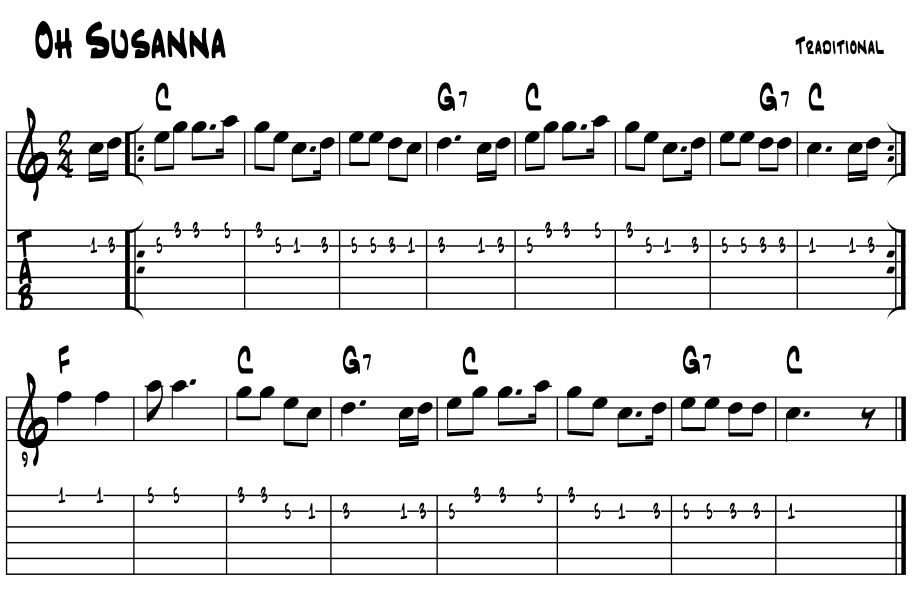 |
Cool? Again the idea that if we can capture the 'jaunty air' of melodies like this, we'll better infuse that 'air' into our improv lines. These are the songs many of our musical heros learned as kids, as so many of these Americana lines were part of the public school curriculum of the last century. Written out in 2/4 gets us down to the 16th note prolation of the beat. |
We've a couple of super nice melodies created with these six pitches, both of which make for nice chord melody arrangements for guitar. Check them out if you're curious and looking for some solo guitar pieces. |
We have music history today to remind us of times past and the way folks thought back then. There's a verse to this old tune that reflects a different world in a different time, one we each of us through learning can remember so as to bring forth a better sense of the American ideals, truth and justice in our own generations. Good to know the history as it points to a better way forward. |
"The piano keys are black and white but they sound like a million colors in your mind." |
wiki ~ Maria Christina Mena |
~ super theory game changer ~ |
'Over the changes' with seven pitches. From six we add one; the leading tone or 7th scale step, which opens a whole new section of palette for the improv artist. This next chart builds up using the seven pitches of the diatonic major scale. This ancient group is the true source for so much Americana musical improv for a wide wide spectrum of our styles. |
melody pitches |
seven pitches of the diatonic scale |
|||||||
scale degrees |
1 |
2 |
3 |
4 |
5 |
6 |
7 |
8 |
C pentatonic scale |
C |
D |
E |
. |
G |
A |
. |
C |
with added 4th |
C |
D |
E |
F |
G |
A |
. |
C |
diatonic seven |
C |
D |
E |
F |
G |
A |
B |
C |
Now with seven pitches in our group we get some new improv potentials, we've the pitches to diatonically build all of associated triads and extended chords for each of our key centers; we also regain all the modes, those also ancient groups that improvisors love to jam on and explore for the ancient lines that live within. |
We also get a two pitch tritone, so a strong dissonance and something to keep on an ear on as we create our lines. Examine the diatonic pitches of the paired relative C major / A minor grouping of pitches. Rote memorize this chart for maximum bennies. Example 4. |
scale degrees |
1 |
2 |
3 |
4 |
5 |
6 |
7 |
8 |
C major |
C |
D |
E |
F |
G |
A |
B |
C |
arpeggio |
C |
E |
G |
B |
D |
F |
A |
C |
One / C major |
C |
E |
G |
. |
. |
. |
. |
. |
Four / F major |
. |
. |
. |
. |
. |
F |
A |
C |
Five / G major |
. |
. |
G |
B |
D |
. |
. |
. |
. |
. |
. |
. |
. |
. |
. |
. |
. |
A minor |
A |
B |
C |
D |
E |
F |
G |
A |
arpeggio |
A |
C |
E |
G |
B |
D |
F |
A |
One / A minor |
A |
C |
E |
. |
. |
. |
. |
. |
Four / D minor |
. |
. |
. |
. |
. |
D |
F |
A |
Five / E minor |
. |
. |
E |
G |
B |
. |
. |
. |
Now having seven pitches for creating melodic ideas 'over' the One / Four / Five of both major and minor combined, is an awfully big chunk of the theory and provides a ton of the resource to improv on the Americana music we know and have come to love. In this next idea we'll first run the seven pitches over their respective One / Four and Five chords. Example 4a. |
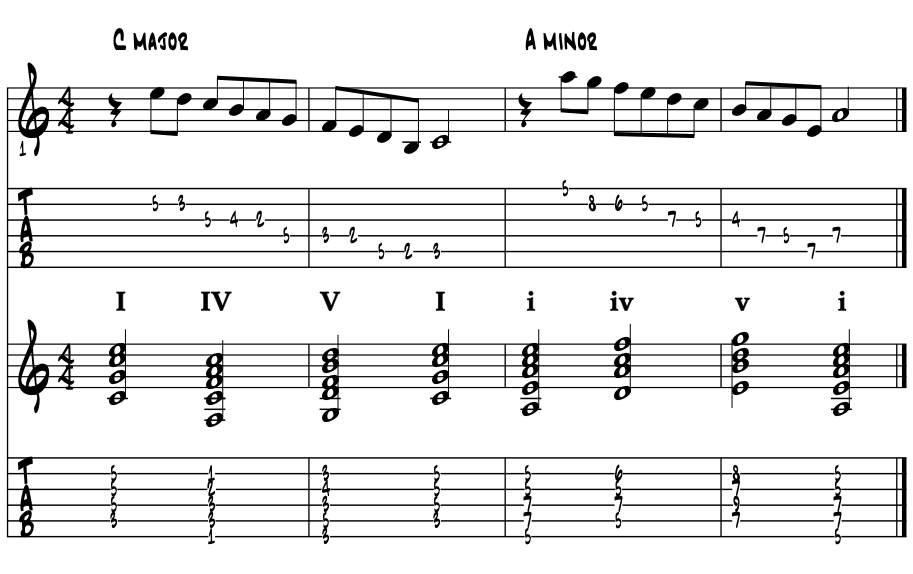 |
Simply scale wise lines whose pitches match up with the pitches the chords are made from. See the upper and lower case Roman numerals to label the chords? We theorists often find numerical equivalents for our various musical components. Upper case for major, lower case for minor. In this next idea we mix up the major and minor chords together and find a melody idea over these changes. Example 4b. |
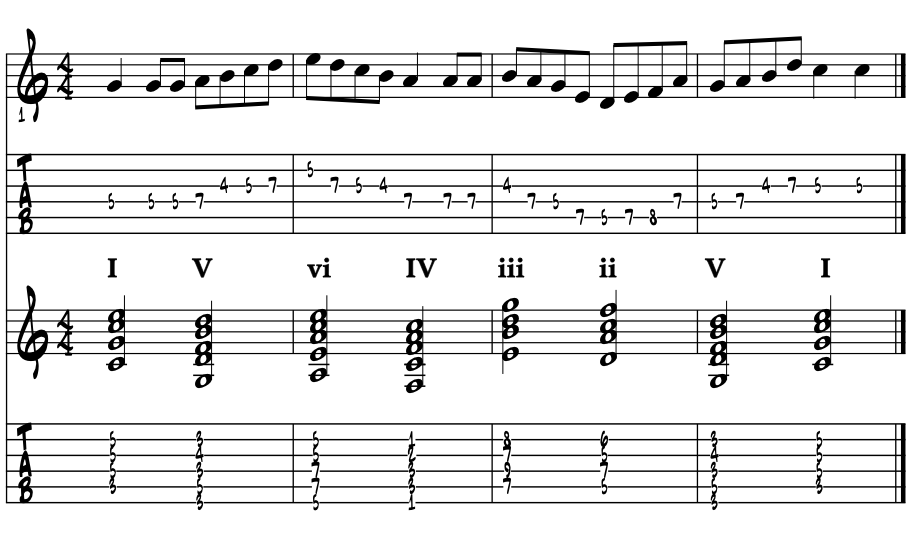 |
See how the Roman numerals evolved? We're now measuring everything from the pitch C, One, which is the root or tonic of our key center in these examples. So probably starting to sound a bit on the 'classical' side of things? No real surprise there as the classical cats totally dig the diatonic and of course there's no real blues in the classical way of the theory. Here's some added 'blues hue' grace notes over the same changes. Example 4c. |
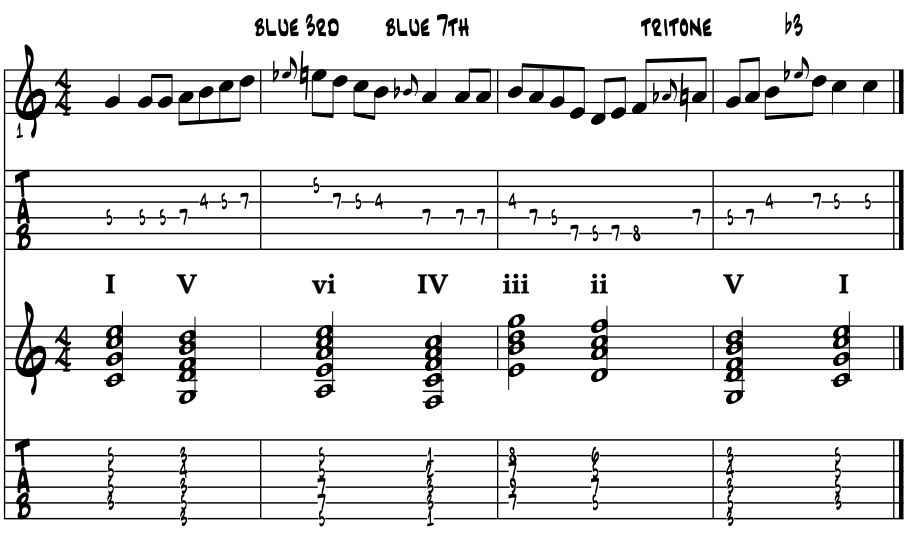 |
Cheesy? No? Cool. Taking on some gospel ya say? Sure is. Our gospel is the perfect blend of an 'in tune' piano with voices deep steeped in the Americana storytelling traditions of the 'blues hue.' Following along the same sort of ideas but now focused from a minor key center. Example 4e. |
|
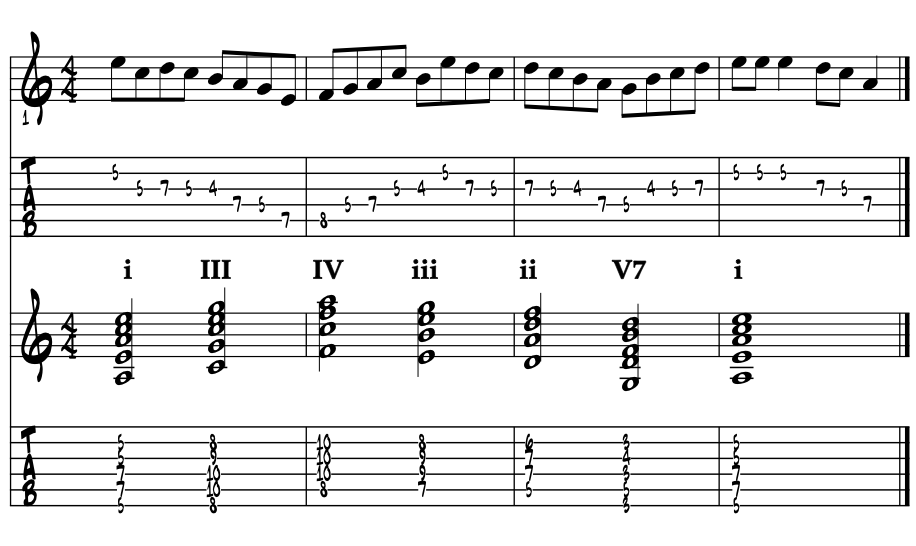 |
These sorts of diatonic ideas of melody and harmony creates the majority of our musics over the last 150 years or so. Unless it's the blues? Right, the blues is in theory a bit different as described above and throughout. There's another aspect here and that is how the pentatonic groups play a rather important improv role over these same changes. The pentatonic groups might be easier to bluesify or blue hue. Surely in minor. Ex. 4e. |
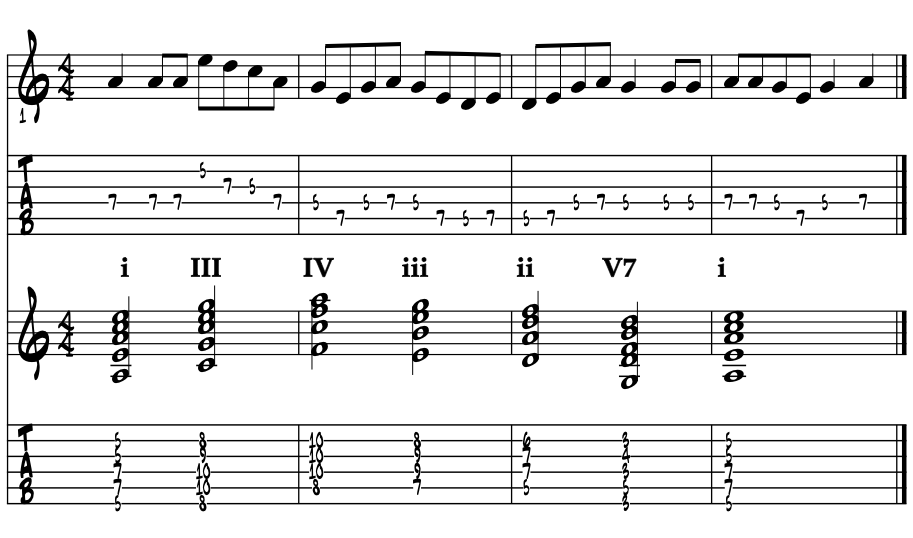 |
Pentatonic and the blue hue. Sounds light and less busy. Here's the pentatonic major over the changes from the C major example above with blue hue highlights. Example 4f. |
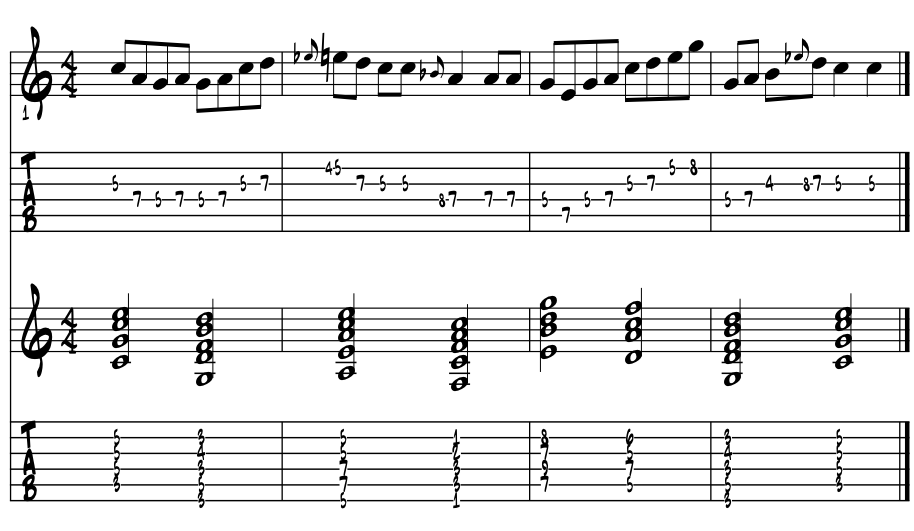 |
Might be even more gospel hued with the pentatonic group with some blue high lights. So we've simply theorized about the pitches, labeled things up along the way. Now we're mixing elements and creating sounds that fit into a style. And that's part of how theory knowledge empowers the artist, who often looks to other styles to evolve their own work thus putting the 'modern' theory perspective in Modern Guitar. |
Review ~ pentatonic, diatonic and the tritone. With the above discussion in mind, let's in table format again compare the letter name pitches these two groups. Building from the root pitch 'C.' Example 5. |
melody pitches |
Americana improv groups of pitches |
|||||||
scale degrees |
1 |
2 |
3 |
4 |
5 |
6 |
7 |
8 |
C pentatonic scale |
C |
D |
E |
. |
G |
A |
. |
C |
C major scale |
C |
D |
E |
F |
G |
A |
B |
C |
So we can see the F / B addition to the major scale group of pitches. These two sounded together create the tritone dissonance that we associate with dominant harmony and the blues. Without these two pitches we have the 'no really bad pitches' magic of the pentatonic group while still creating memorable and important musics. |
This discussion is the basic theory of 'soloing over the changes' in Americana improv. What we mostly do is find the parent scale pitches that was used to create the melody and chords of a song and use these pitches for our improvs. Our music is mostly diatonic major scale based, for with the seven pitches we get to diatonically build up most of the necessary chords. The five note pentatonics, said to have 'no wrong notes', are among the most popular of the groups for soloing over these diatonic harmonies built from the seven pitches of the major scale. Most anytime we can add in the blues hue, when tastefully done, seems to generate a smile or two and tie us back into part of our Americana core; the blues. |
Next up. Soloing over the changes is most of it for some players and a part of it for others. The other part? Here in Essentials we term it soloing 'through the changes.' In this approach we outline the pitches of the chord to create our improv melodies. When we combine the two, in theory and practice, we're well on our way to understanding the basis of Americana improv. For as the harmony of the music evolves, even by simply having more chords in a progression, there's a historical school of improv that wants to hear the changes in the lines. Often called playing 'inside the changes' it is what many jazz leaning artists love to do. Choose to further explore. |
"When you play, play what's in your heart, what's in your mind, not what somebody else plays. You have to be yourself." |
wiki ~ Herb Hardesty w / Fats Domino |
References. References for this page's information comes from school, books and the bandstand and made way easier by the folks along the way. |
Find a mentor / e-book / academia Alaska. Always good to have a mentor when learning about things new to us. And with music and its magics, nice to have a friend or two ask questions and collaborate with. Seek and ye shall find. Local high schools, libraries, friends and family, musicians in your home town ... just ask around, someone will know someone who knows someone about music and can help you with your studies in the musical arts. |
|
Always keep in mind that all along life's journey there will be folks to help us and also folks we can help ... for we are not in this endeavor alone :) The now ancient natural truth is that we each are responsible for our own education. Positive answer this always 'to live by' question; 'who is responsible for your education ... ? |
Intensive tutoring. Luckily for musical artists like us, the learning dip of the 'covid years' can vanish quickly with intensive tutoring. For all disciplines; including all the sciences and the 'hands on' trade schools, that with tutoring, learning blossoms to 'catch us up.' In music ? The 'theory' of making musical art is built with just the 12 unique pitches, so easy to master with mentorship. And in 'practice ?' Luckily old school, the foundation that 'all responsibility for self betterment is ours alone.' Which in music, and same for all the arts, means to do what we really love to do ... to make music :) |
 |
"These books, and your capacity to understand them, are just the same in all places. Always bear in mind that your own resolution to succeed, is more important than any other one thing." |
|
Academia references of Alaska. And when you need university level answers to your questions and musings, and especially if you are considering a career in music and looking to continue your formal studies, begin to e-reach out to the Alaska University Music Campus communities and begin a dialogue with some of Alaska's finest resident maestros ! |
